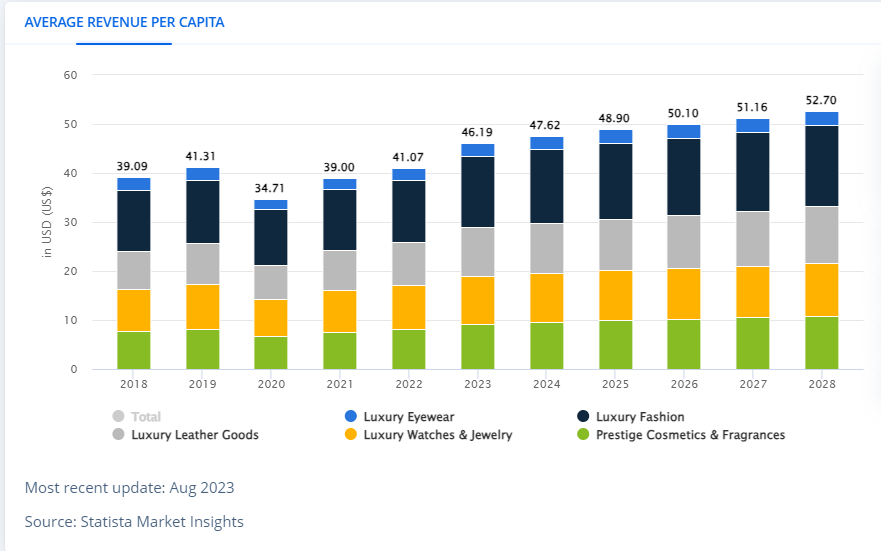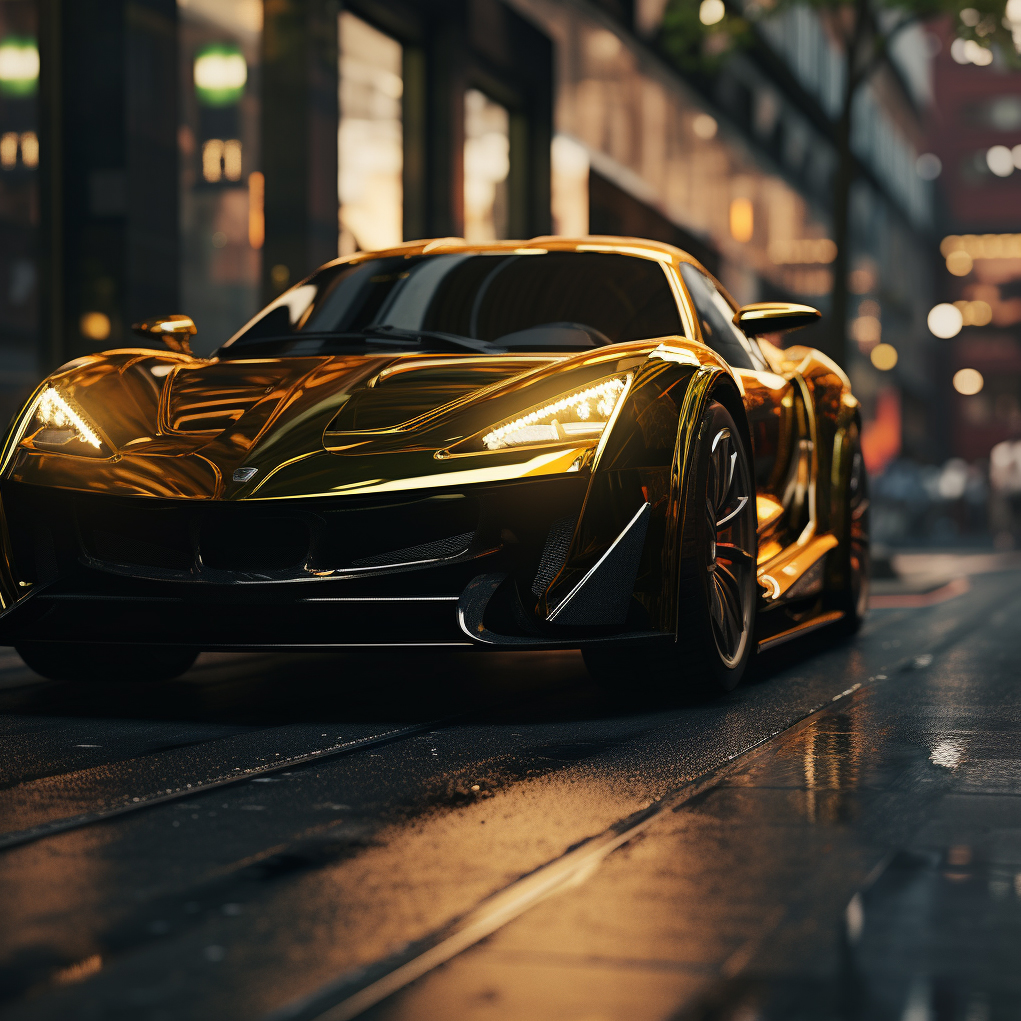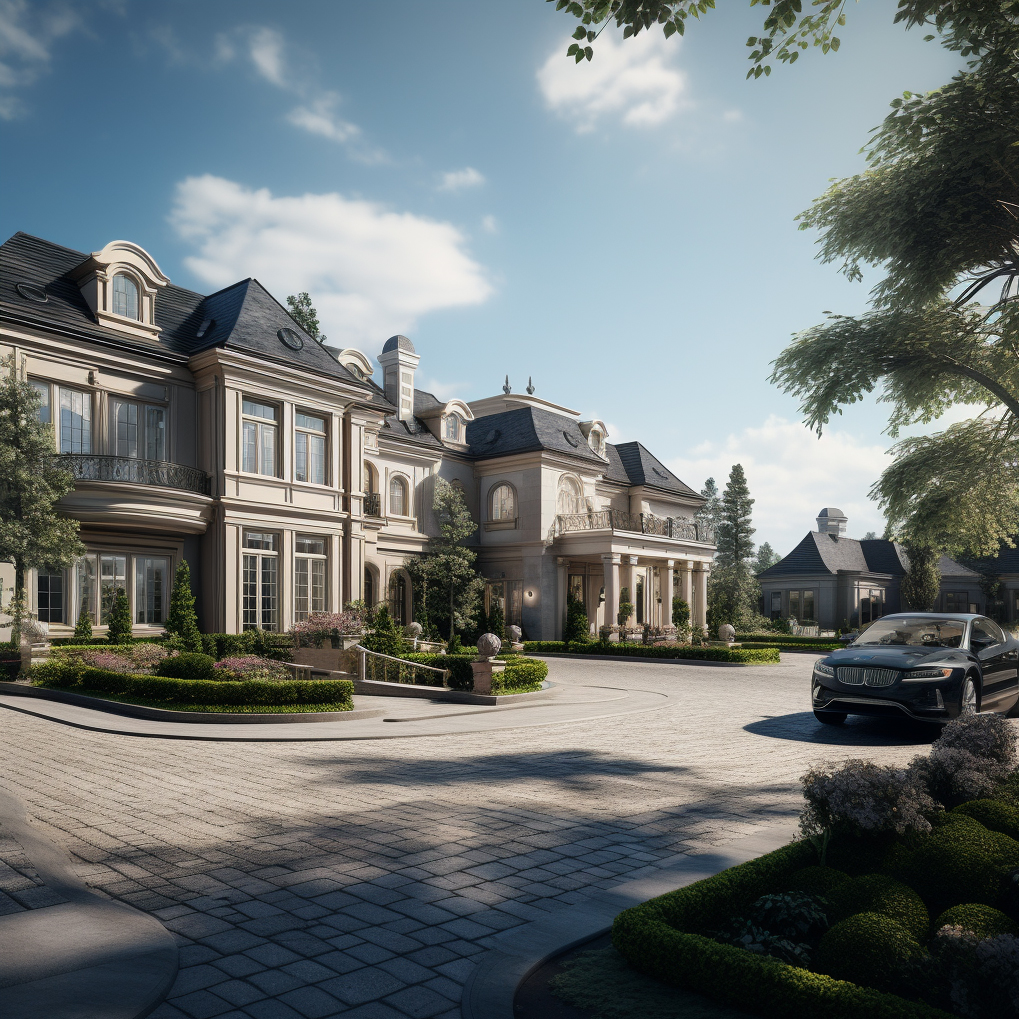During a global cost-of-living crisis, the luxury market has not only weathered the storm but has experienced unprecedented growth. While the pandemic and wars have plunged many into poverty, luxury brands have thrived, breaking records and surpassing market expectations.
In this article, we will explore the driving forces behind the boom in the luxury sector, focusing on four key segments: personal luxury goods, luxury cars, private jets, and luxury real estate.
Personal Luxury Goods: A Beacon of Escapism
The market for personal luxury goods, an umbrella term encompassing high-end clothing, premium cosmetics, designer handbags, and exquisite jewelry, has enjoyed a rich history of consistent growth over several decades. This industry has shown an uncanny resilience, often bouncing back stronger after periods of economic downturns, such as the financial crisis of 2008 and the more recent global pandemic. Despite these temporary interruptions, sales have not only regained their pre-crisis levels but have, in fact, surged to unprecedented heights.
Such resilience can be attributed to the consumer behavior associated with luxury consumption. In times of hardship or uncertainty, consumers often seek solace in luxury items, viewing them as a means of escape from the challenges of the times. These items, symbolic of success, prestige, and quality, offer a form of escapism, allowing consumers to momentarily distance themselves from the harsh realities of the world.

An epitome of this trend is LVMH Moët Hennessy – Louis Vuitton, the world-renowned French multinational luxury goods conglomerate. In a significant milestone, LVMH recently etched its name in history by becoming the first-ever European company to surpass the 500 billion euros mark in market value, a testament to the robust and buoyant nature of the luxury market.
This remarkable surge in demand can be traced back to multiple factors. One key component is the unexpected rebound in consumer spending in Europe and the U.S., following the easing of pandemic-related restrictions. Yet, an even more substantial contributor to this growth has been the Chinese luxury consumer.

In 2021, affluent Chinese families, numbering around 100 million, demonstrated an insatiable appetite for luxury goods, thereby establishing China as a critical market for luxury retailers. Market research suggests that this number is set to double by 2025, reaching an estimated 200 million. This exponential growth in the number of wealthy Chinese consumers is poised to drive the luxury market to new heights, making them an integral part of the expansion strategy for luxury retailers worldwide.

Luxury Cars: Harnessing the Wave of Exclusivity
In stark contrast to the stagnant mainstream automotive market, the luxury car sector is demonstrating robust exuberance. This segment, especially vehicles carrying price tags that exceed half a million dollars, is anticipated to witness an impressive 14% annual growth in sales until 2031, according to the forecast.
This thriving trend is largely underpinned by the strategic scarcity principle employed by luxury car manufacturers. Esteemed brands such as Ferrari are known to deliberately restrict their production numbers, a tactic that has proven successful in maintaining an aura of exclusivity and preserving their elite status.
The recent unprecedented global events have only served to amplify this growth. The COVID-19 pandemic has triggered a notable shift in consumer behavior, with an increased preference for personal transportation over public or shared means. This shift, combined with the worldwide microchip shortage, contributed to the surge in luxury car sales. The scarcity of these essential components has led to a production slowdown in the mainstream automotive sector, further widening the gap between supply and demand.

Furthermore, the luxury car market is gaining substantial traction among the affluent populace, particularly in Asia and the Middle East, where the number of high-net-worth individuals is on a steady rise. These wealthy individuals are more inclined to invest in high-end vehicles, primarily due to their perceived value retention. Unlike their mass-market counterparts, which tend to depreciate rapidly, luxury vehicles are perceived to hold their value better over time.
Adding another layer of appeal to these opulent vehicles is their advanced technology offerings. Luxury car manufacturers are at the forefront of introducing innovative features such as advanced connectivity, autonomous-driving options, and powertrain electrification technologies. This propensity for innovation further bolsters their allure to tech-savvy consumers, driving sales even higher.

The luxury car market is also witnessing a diversification in terms of price brands. The growth rates vary across different manufacturer suggested retail price (MSRP) tiers. For instance, the $80,000 to $149,000 segment is expected to grow by more than 8 percent annually, while the $150,000 to $299,000 and $300,000 to $500,000 segments are likely to experience 10 and 9 percent annual growth in sales, respectively. This chain of growth rates across diverse price bands underlines the nuanced consumer preferences in the luxury car market.
Private Jets: Soaring Above Commercial Constraints
The private jet industry, often seen as the pinnacle of luxury transportation, has also witnessed a significant resurgence amidst the pandemic. According to reports, there has been a 50-60% surge in demand for charter flights during this period. This trend can be attributed to the unique benefits offered by private jet travel, which include enhanced flexibility, safety, and convenience, especially when compared to their commercial counterparts.
Primarily, the pandemic-induced restrictions severely affected commercial air travel. In 2020, for example, global commercial flights saw a dramatic decrease, with many airlines grounding a substantial portion of their fleet due to the lack of demand. In contrast, private jet charters experienced a boom. Individuals and corporations, particularly those with the financial means, began to favor this travel mode to bypass the limitations imposed by commercial airlines.

Furthermore, the luxury car market is gaining substantial traction among the affluent populace, particularly in Asia and the Middle East, where the number of high-net-worth individuals is on a steady rise. These wealthy individuals are more inclined to invest in high-end vehicles, primarily due to their perceived value retention. Unlike their mass-market counterparts, which tend to depreciate rapidly, luxury vehicles are perceived to hold their value better over time.
Adding another layer of appeal to these opulent vehicles is their advanced technology offerings. Luxury car manufacturers are at the forefront of introducing innovative features such as advanced connectivity, autonomous-driving options, and powertrain electrification technologies. This propensity for innovation further bolsters their allure to tech-savvy consumers, driving sales even higher.
The luxury car market is also witnessing a diversification in terms of price brands. The growth rates vary across different manufacturer suggested retail price (MSRP) tiers. For instance, the $80,000 to $149,000 segment is expected to grow by more than 8 percent annually, while the $150,000 to $299,000 and $300,000 to $500,000 segments are likely to experience 10 and 9 percent annual growth in sales, respectively. This chain of growth rates across diverse price bands underlines the nuanced consumer preferences in the luxury car market.
Luxury Real Estate: Resilient Amidst Economic Challenges
In a recent analysis of the global real estate market, it was observed that luxury real estate sales experienced a significant surge in 2022. More specifically, transactions in this segment grew by an impressive 35% from 2021, a trend fueled by a confluence of factors.
One of the most influential factors is the shift towards remote work. In the early 2020, a global transition was initiated towards remote work arrangements. With employees no longer tethered to their office locations, the geography of potential residences expanded dramatically. This trend was particularly pronounced among high-income earners, many of whom sought to take advantage of the new flexibility to upgrade their living arrangements.

Another factor contributing to this increase is the pursuit of more spacious living quarters. As people spent more time at home due to lockdowns and social distancing measures, the value of space, both indoor and outdoor, soared. Luxury residences, often characterized by their generous square footage and extensive amenities, became increasingly appealing. For instance, in the U.S, locations like the Hamptons and Aspen saw a spike in demand as affluent city dwellers sought homes with more space and natural surroundings.

Furthermore, this sector has proven resilient to the high-interest rates that have been affecting the broader real estate market. Wealthy buyers, who often make purchases in cash, are generally less sensitive to fluctuations in interest rates. A strong example of this trend was seen in Miami, Florida, where despite rising interest rates in 2022, luxury condos in areas like Miami Beach and Brickell continued to sell at record prices. The resilience of these cash-rich buyers provides a buffer for the luxury real estate market, allowing it to weather economic storms that may dampen activity in other real estate segments.
However, despite these positive trends, it is vital to note the potential for a slowdown. According to industry experts, the initial surge of relocations and upgrades triggered by the pandemic is likely to taper off as people gradually settle into their new living arrangements. This prediction is supported by data from Knight Frank's 2022 Wealth Report, which suggests that the rate of growth in the global luxury real estate market may slow down in the coming years.
Conclusion:
The luxury market's ability to adapt, evolve, and thrive amidst global challenges is a testament to its resilience. With the affluence of emerging markets, especially in Asia, and a younger demographic contributing to sustained growth, the future looks promising for luxury goods, cars, private jets, and real estate.
As we witness a wealth transfer over the next decade, the luxury sector is poised for long-term, sustainable growth. The key lies in maintaining exclusivity, adapting to changing consumer preferences, and embracing the cyclical nature of economic trends.
